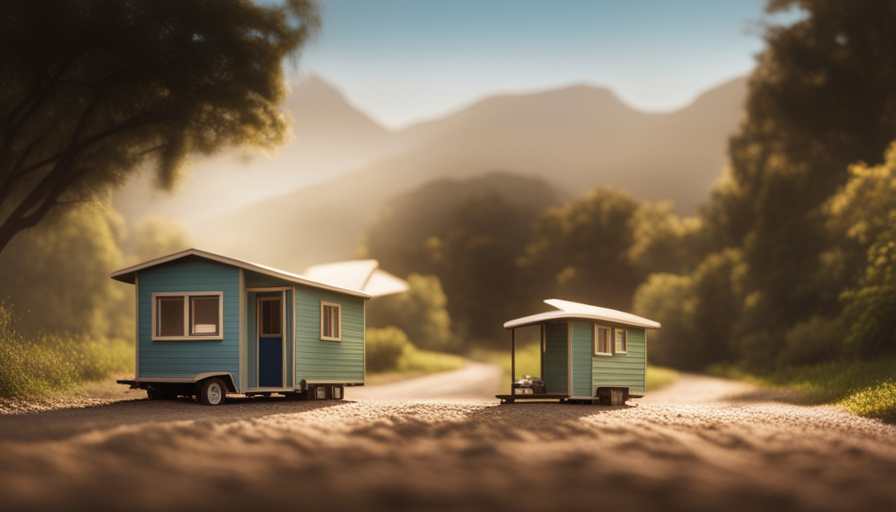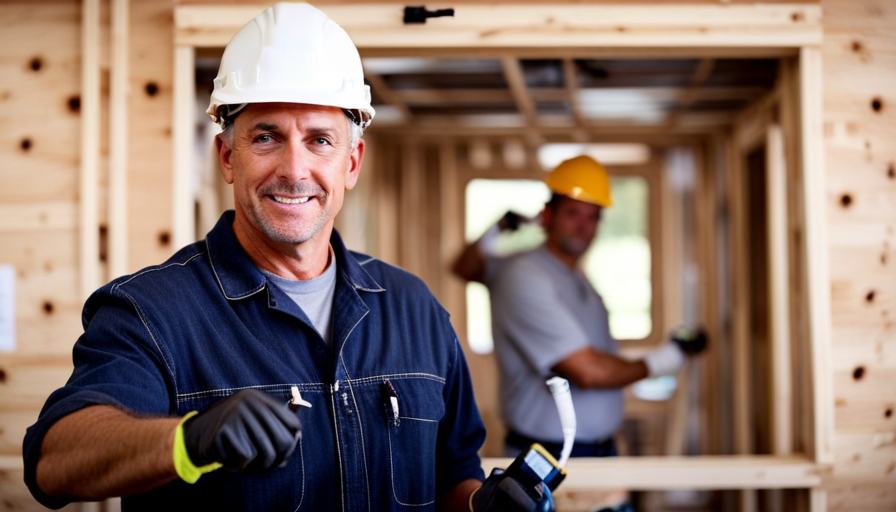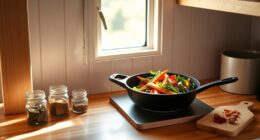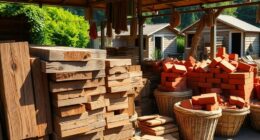Interestingly, with the rising costs of daily living and the growing interest in sustainable living, the tiny house movement has gained significant popularity in recent years. This movement, which advocates for living in small, efficient homes, has a history that dates back long before its current recognition.
Throughout history, societies have embraced nomadic living and small dwellings as a way to adapt to their surroundings and prioritize simplicity. In the 19th century, Henry David Thoreau’s experiment in living simply in a tiny cabin at Walden Pond helped inspire the modern tiny house movement. In the 20th century, minimalism became a popular design philosophy, further influencing the movement. Early examples of modern tiny houses emerged, and the impact of the housing crisis propelled the movement forward.
Today, tiny house communities and events have flourished, although legal and zoning challenges persist. Sustainability and environmental consciousness also play a vital role in the movement’s growth. As the movement continues to evolve, its future holds exciting possibilities for those seeking a simpler, more intentional way of living.
Key Takeaways
- The tiny house movement has its roots in nomadic living and small dwellings throughout history.
- Henry David Thoreau’s experiment in living simply, documented in his book ‘Walden’, greatly influenced the modern tiny house movement.
- The rise of minimalism in the 20th century further influenced the development of tiny houses, prioritizing simplicity and functionality.
- The housing crisis and affordability constraints contribute to the popularity of tiny houses as an affordable alternative to traditional housing.
Nomadic Living and Small Dwellings Throughout History
Did you know that nomadic living and small dwellings have been a part of human history for centuries?
Nomadic tribes, such as the Bedouins, have been living in portable tents and small dwellings for generations. These tribes have mastered the art of living with minimal possessions and maximizing the use of space.
In ancient times, small dwellings were also prevalent. For example, the Native Americans built tepees and wigwams, which were easily assembled and disassembled, enabling them to move with the seasons or in search of resources.
The influence of nomadic living and small dwellings can also be seen in the writings of Henry David Thoreau and the subsequent tiny cabin movement. Thoreau, in his book ‘Walden,’ documented his experience of living in a small cabin near a pond for two years. He believed in simplifying life and being self-sufficient. Thoreau’s ideas inspired many to embrace a simpler lifestyle and sparked the tiny cabin movement, where people started building and living in small, minimalist homes.
Transitioning into the next section, the influence of Thoreau and the tiny cabin movement can still be seen today in the modern tiny house movement.
Influence of Henry David Thoreau and the Tiny Cabin Movement
Imagine yourself stepping into a world where the simplicity of Henry David Thoreau’s tiny cabin served as a blueprint for a lifestyle that embraced minimalism and connection with nature. Henry David Thoreau’s influence on the tiny cabin movement can’t be overstated.
His book, ‘Walden,’ published in 1854, documented his experiences living in a small cabin near Walden Pond in Massachusetts. Thoreau’s retreat into nature and his focus on self-sufficiency resonated with many, inspiring a new way of living.
The impact of Thoreau’s tiny cabin movement can be seen in modern architecture. Architects and designers have drawn inspiration from Thoreau’s philosophy of simplicity and minimalism, incorporating these principles into their designs. Tiny houses, often no larger than a few hundred square feet, have gained popularity as a sustainable and affordable housing option. They provide a way for people to live with less, reducing their environmental footprint and simplifying their lives.
Incorporating Thoreau’s ideas into modern architecture has allowed for creative and innovative designs that maximize space and functionality. The tiny cabin movement has influenced not only residential architecture but also the design of commercial spaces, such as cafes, offices, and retail stores. By embracing minimalism and connection with nature, these spaces create a sense of tranquility and harmony.
As we transition into the subsequent section about the rise of minimalism in the 20th century, it’s important to recognize the lasting impact of Thoreau’s tiny cabin movement. The principles of simplicity and connection with nature continue to shape our understanding of architecture and design, inspiring us to create spaces that promote well-being and sustainable living.
The Rise of Minimalism in the 20th Century
The 20th century witnessed a remarkable surge in minimalism, a design movement that prioritized simplicity and functionality. This rise of minimalism was influenced by various factors, including the ideas put forth by Henry David Thoreau and the Tiny Cabin Movement.
Thoreau’s book, ‘Walden,’ published in 1854, advocated for a simple lifestyle in harmony with nature. His ideas resonated with many people, inspiring them to seek a more minimalistic way of living.
During the 20th century, minimalism gained traction as a response to the excesses of consumer culture and the rapid advancements in technology. People began to embrace a simpler and more streamlined aesthetic, focusing on the essentials and eliminating unnecessary clutter. The principles of minimalism were applied not only to architecture and design but also to art, fashion, and lifestyle choices.
This movement had a profound impact on the development of tiny houses. The ethos of minimalism lent itself perfectly to the concept of living in small and compact spaces. By prioritizing functionality and efficiency, minimalism allowed for the creation of tiny houses that maximized every square inch of space.
The rise of minimalism in the 20th century had a significant influence on the development of tiny houses. Its emphasis on simplicity and functionality provided a solid foundation for the design principles of modern tiny homes. With this understanding, we can now explore the early examples of these innovative dwellings.
Early Examples of Modern Tiny Houses
From the quaint cottages nestled in the English countryside to the whimsical treehouses hidden among the lush forests, early examples of modern tiny houses transport us to a world of enchantment and imagination. These early pioneers of the tiny house movement were visionaries who sought to challenge the norms of traditional housing and embrace a simpler, more sustainable way of living. They experimented with architectural innovations that allowed for maximum functionality and minimal footprint.
One such pioneer was Henry David Thoreau, who built his famous cabin in the woods near Walden Pond in 1845. Thoreau’s cabin was a testament to his philosophy of simple living and self-sufficiency. Another notable example is the Wee House, designed by architect Alastair Parvin, which was built in London in 2011. The Wee House showcased the possibilities of compact living in an urban setting, proving that tiny houses could be a viable solution to the housing crisis in crowded cities.
These early examples of modern tiny houses laid the foundation for the movement that we see today. They inspired a new generation of architects and designers to think outside the box and create innovative, sustainable housing solutions. As we delve deeper into the impact of the housing crisis on the tiny house movement, we will see how these early pioneers paved the way for a revolution in housing design and affordability.
The Impact of the Housing Crisis on the Tiny House Movement
With skyrocketing housing costs and limited availability, the housing crisis has propelled the popularity of tiny houses as an affordable and sustainable alternative. One of the key factors contributing to the rise of the tiny house movement is the impact of housing policies. Many cities and towns have zoning and building regulations that make it difficult for individuals to build or live in small, affordable homes. These policies often require minimum square footage or prohibit tiny houses on wheels, limiting their options for those seeking affordable housing solutions.
Additionally, affordability constraints have played a significant role in the growth of the tiny house movement. As housing costs continue to rise, many people find themselves unable to afford traditional homes or burdened by high mortgage payments. Tiny houses offer a more attainable option, allowing individuals to live debt-free or with significantly reduced housing costs.
The housing crisis and affordability concerns have led many people to reconsider their housing choices and seek out more sustainable and affordable alternatives like tiny houses. As we transition into the subsequent section about the role of television shows in popularizing tiny houses, it is clear that the housing crisis has been a driving force behind the growing interest in tiny house living.
The Role of Television Shows in Popularizing Tiny Houses
The impact of the housing crisis on the tiny house movement has been significant, with many people seeking alternative, affordable housing options. However, another factor that has contributed to the popularity of tiny houses is the role of television shows.
Television shows like ‘Tiny House Nation’ and ‘Tiny House Hunters’ have played a crucial role in popularizing the tiny house movement. These shows showcase the process of building and living in a tiny house, highlighting the benefits and challenges of this lifestyle. They have brought the concept of tiny houses into the mainstream, making it more accessible and appealing to a wider audience.
The television influence on the tiny house movement cannot be underestimated. It has sparked a cultural impact, inspiring people to consider downsizing and simplifying their lives. Watching others embrace the tiny house lifestyle on television has made it seem more attainable and desirable.
Television shows have played a significant role in popularizing the tiny house movement. They have brought attention to the concept of tiny houses and have influenced cultural perceptions of what constitutes a home. As a result, the tiny house movement has gained momentum and continues to grow.
Next, let’s explore the growth of tiny house communities and events, which further exemplify the appeal and practicality of this lifestyle.
The Growth of Tiny House Communities and Events
Imagine a vibrant community of like-minded individuals, coming together to share their passion for small-scale living and innovative design. This is the reality of the growing tiny house communities across the country.
As the housing crisis continues to impact many people, the tiny house movement has gained momentum as an alternative solution. These communities provide a sense of belonging and support for those who choose to downsize and live in tiny homes.
The growth of tiny house communities can be attributed to several factors. Firstly, the affordability of tiny homes allows people to achieve the dream of homeownership, even in the face of rising housing costs. Additionally, the environmentally-friendly nature of tiny houses appeals to those who are conscious of their carbon footprint. These communities often emphasize sustainable living practices, such as composting, rainwater harvesting, and renewable energy sources.
Furthermore, tiny house events have become popular gathering places for enthusiasts and aspiring tiny house dwellers. These events offer a platform for education, networking, and showcasing innovative designs. From tiny house festivals to workshops on building and design, these events foster a sense of community and provide valuable resources for those interested in joining the movement.
As the tiny house movement continues to grow, it’s not without its challenges. Legal and zoning issues pose significant obstacles for tiny house dwellers. In the next section, we’ll explore the legal and zoning challenges faced by these individuals, highlighting the steps they’re taking to overcome these barriers.
Legal and Zoning Challenges Faced by Tiny House Dwellers
As we’ve seen, the growth of tiny house communities and events has been remarkable. However, it’s not all sunshine and rainbows for tiny house dwellers. Legal challenges and zoning restrictions pose significant obstacles for those who choose to live in these compact dwellings.
One of the primary legal challenges faced by tiny house dwellers is the lack of specific regulations that address the unique nature of these homes. Many local zoning codes were written with traditional homes in mind and don’t account for the smaller footprint and mobility of tiny houses. This often results in tiny house dwellers being in violation of zoning regulations, leading to fines and even eviction.
Furthermore, some municipalities have minimum size requirements for homes, which directly conflict with the tiny house movement. These restrictions can make it difficult, if not impossible, for individuals to legally live in a tiny house in certain areas.
Despite these legal and zoning challenges, the tiny house movement continues to grow, as people are drawn to the simplicity and affordability that these homes offer. In the next section, we’ll explore the role of sustainability and environmental consciousness in the tiny house movement. Together, these factors are shaping the future of housing and challenging traditional notions of what it means to live in a home.
The Role of Sustainability and Environmental Consciousness
Sustainability and environmental consciousness play a crucial role in shaping the future of housing and challenging traditional notions of what it means to have a home. As the tiny house movement gains momentum, individuals are increasingly looking for ways to reduce their environmental footprint and live more sustainably. Here are five key factors that highlight the role of sustainability and environmental consciousness in the tiny house movement:
-
Sustainable Building Materials: Tiny house dwellers often opt for eco-friendly building materials such as reclaimed wood, recycled metal, and salvaged materials. These choices not only reduce waste but also promote a more sustainable construction process.
-
Energy Efficiency: Tiny houses are designed to be energy-efficient, with features like solar panels, rainwater collection systems, and composting toilets. These off-grid living options allow occupants to minimize their reliance on traditional energy sources and reduce their carbon footprint.
-
Minimalism and Waste Reduction: The tiny house lifestyle encourages a minimalist mindset, where individuals prioritize experiences over possessions. With limited space, tiny house dwellers are forced to be intentional about what they bring into their homes, leading to reduced consumption and waste.
-
Connection with Nature: Many tiny house owners choose to live in natural surroundings, embracing the beauty of the outdoors. This connection with nature fosters a greater appreciation for the environment and a desire to protect it.
-
Community and Sharing: The tiny house movement often promotes community living and resource sharing. By pooling resources and living in close proximity, tiny house communities can reduce their impact on the environment and create a more sustainable way of life.
Sustainability and environmental consciousness are driving forces behind the tiny house movement. As more people recognize the importance of living in harmony with the planet, the future of the tiny house movement looks promising.
Transitioning into the next section about the future of the tiny house movement, it is clear that sustainable practices will continue to shape the way we think about housing and redefine the concept of home.
The Future of the Tiny House Movement
In the years to come, the tiny house craze will continue to revolutionize the way we view and define our living spaces. With the advancements in technology, the impact of technology on the tiny house movement will be significant. From smart home features to energy-efficient appliances, technology will play a crucial role in making tiny houses more sustainable and comfortable.
One of the challenges of downsizing to a tiny house is adjusting to a smaller living space. However, with innovative design solutions and the use of multifunctional furniture, the future of the tiny house movement will offer more efficient use of space without compromising on comfort.
To engage the audience and provide a comprehensive analysis, I have created a table that highlights the impact of technology and the challenges of downsizing in the future of the tiny house movement:
| Impact of Technology | Challenges of Downsizing |
|---|---|
| Smart home features | Adjusting to smaller living space |
| Energy-efficient appliances | Efficient use of space |
| Innovative design solutions | Comfort in a limited area |
By incorporating these advancements and addressing the challenges, the tiny house movement will continue to thrive and attract individuals seeking a simpler, more sustainable lifestyle. As technology continues to evolve and solutions for downsizing become more accessible, the future of the tiny house movement looks bright.
Frequently Asked Questions
What are some examples of small dwellings throughout history that have influenced the tiny house movement?
Examples of small dwellings throughout history that have influenced the tiny house movement include the yurts used by nomadic tribes in Central Asia, the cabins built by early American settlers, and the tiny cottages found in European villages.
These dwellings showcased the efficiency and simplicity of living in a smaller space, inspiring the principles of minimalism and sustainability that are central to the tiny house movement today.
They serve as a reminder that small living spaces can be functional, comfortable, and aesthetically pleasing.
How did Henry David Thoreau and the tiny cabin movement contribute to the development of the tiny house movement?
Henry David Thoreau and the Tiny Cabin Movement played a significant role in the development of the Tiny House Movement. Thoreau’s experiment of living simply in a small cabin in the woods showcased the benefits of minimalism and self-sufficiency. This concept resonated with many people, especially during periods of housing crises.
Thoreau’s ideas influenced the rise of minimalism and tiny houses, with early modern examples such as the Sears Catalog Homes. Overall, Thoreau’s impact on the Tiny House Movement cannot be overstated.
What were some key factors that led to the rise of minimalism in the 20th century and its relation to tiny houses?
The rise of minimalism in the 20th century was influenced by several key factors. One factor was a desire for simplicity and a rejection of materialism.
Another factor was the housing crisis, which led people to seek alternative, affordable housing options such as tiny houses. The tiny house movement emerged as a response to these factors, providing a way for people to live with less and prioritize experiences over possessions.
The minimalist principles of simplicity and sustainability align closely with the ethos of tiny house living.
Can you provide some early examples of modern tiny houses and their designs?
Early modern tiny house examples include the Wee House, designed by Alchemy Architects in 2003. This 336-square-foot home features a compact, efficient layout with a loft bedroom and open living space.
Another innovative design is the Tumbleweed Tiny House Company’s Fencl, introduced in 2010. With its gabled roof and charming exterior, this 130-square-foot home showcases the possibilities of small-scale living.
These early examples demonstrate the creative and functional designs that have become synonymous with the tiny house movement.
How did the housing crisis impact the growth and popularity of the tiny house movement?
The housing crisis had a significant impact on the growth and popularity of the tiny house movement.
As people struggled with high mortgage payments and limited affordable housing options, they turned to alternative solutions like tiny houses.
These small, affordable dwellings gained traction as a viable housing option.
The crisis forced individuals to reevaluate their priorities and seek more sustainable and cost-effective living arrangements, thus fueling the growth and popularity of the tiny house movement.
Conclusion
In conclusion, the tiny house movement has a rich history that dates back centuries, with influences from nomadic living, Henry David Thoreau, and the rise of minimalism.
Despite legal and zoning challenges faced by tiny house dwellers, the movement continues to grow, with the impact of the housing crisis and the desire for sustainable living driving its popularity.
While some may argue that tiny houses are impractical or too small, the movement offers an alternative solution to the current housing crisis and promotes a more conscious way of living.
Hi, I’m Emma. I’m the Editor in Chief of Tiny House 43, a blog all about tiny houses. While tree houses are often associated with childhood, they can be the perfect adult retreat. They offer a cozy space to relax and unwind, surrounded by nature. And since they’re typically built on stilts or raised platforms, they offer stunning views that traditional homes simply can’t match. If you’re looking for a unique and romantic getaway, a tree house tiny house might just be the perfect option.










